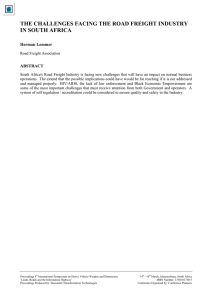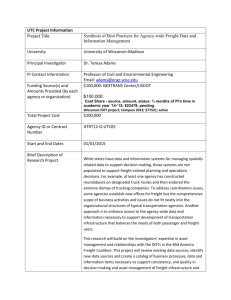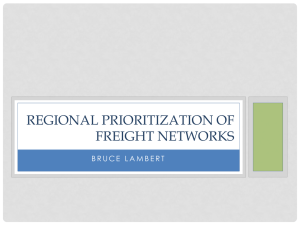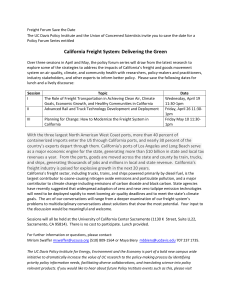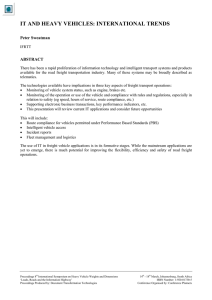Improving Freight System Performance in Metropolitan Areas: A Planning Guide
advertisement
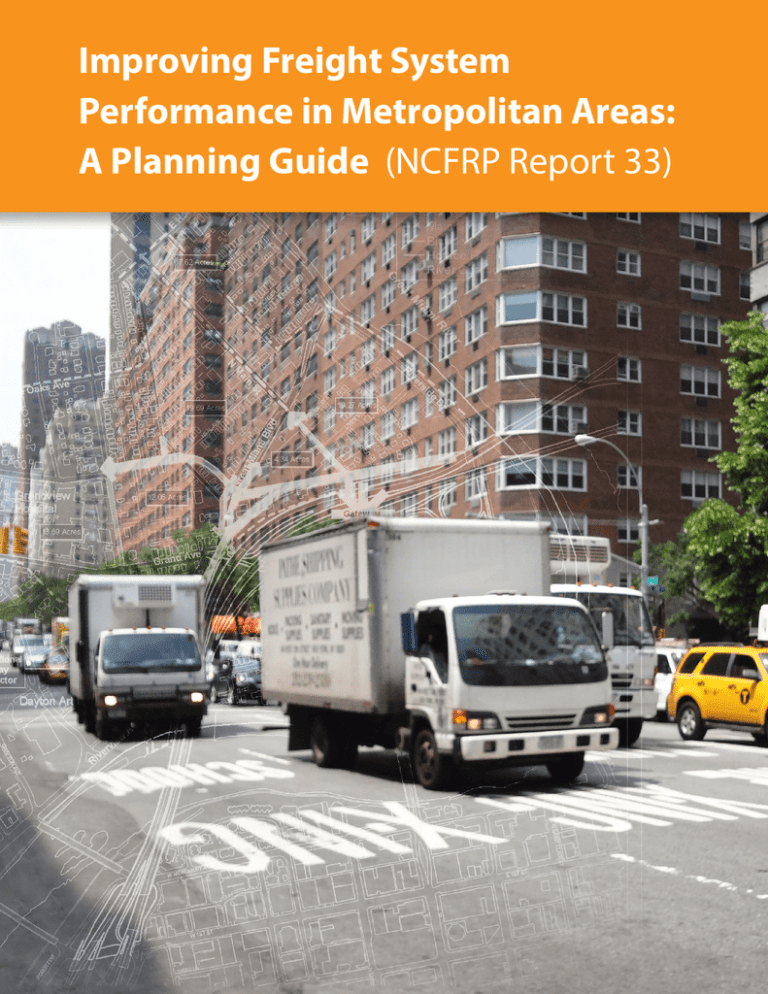
Improving Freight System Performance in Metropolitan Areas: A Planning Guide (NCFRP Report 33) About the Planning Guide T he Planning Guide was designed to serve as a reference for planners requiring practical solutions for urban mobility challenges. It serves as the first comprehensive look not only at implementable freight initiatives, but how those initiatives can be employed in the transportation decisionmaking process. The initiatives presented in the Planning Guide represent a range of alternatives from supply to demand strategies including operational and hybrid groups in between. The solutions have been developed with support of practitioners representing MPOs, city and state DOTs, shippers, carriers, and receivers of various sizes and from different geographic areas. Structure of the Planning Guide Urban Freight Transportation Decision-Making Process • Provide details on how each step, and the tasks within, can be used to find solutions to freight issues; • Proposes a methodology to integrate public-sector initiatives into the urban freight transportation decision-making process with the aim of improving the system performance. The Guide integrates the traditional transportation decisionmaking process with a methodology to identify initiatives to solve real-world challenges. Such integration combines: • A wide spectrum of potential strategies related to supply and demand; • A comprehensive catalog of urban freight solutions including pros and cons along with implementation examples; • A critical review of advantages and disadvantages of each initiative; • Summary pages for each initiative with expected costs to implement; • Planning and design considerations for each initiative proposed. Case Studies • Real-world examples from cities of various sizes in the USA. Initiative 27: Exclusive Truck Lanes Exclusive Truck Lanes Description: Allocation of restricted lane right-of-way exclusively to trucks. Targeted mode: All traffic Geographic scope: Corridor Type of initiative: Traffic Management: Lane Primary objective: Decrease congestion Management Expected costs and level of effort to implement: Exclusive truck lanes require careful planning, extensive stakeholder engagement (both private and public), and an assessment of the potential impacts to all agents of the freight and other relevant economic systems. This initiative requires a large capital investment. Advantages: Disadvantages: - For interstate areas - Require high capital investments Initiative 40: Driver Training Programs o Increase efficiency - Reduce road capacity for other vehicle types o Improve reliability - May not be adequate for metropolitan locationsDriver Training Programs o Enhance safety Description: Programs to improve deliveries by altering driver behaviors and enhancing driver competencies. o Environmental sustainability Drivers’ attitudes and behaviors can directly affect delivery efficiency, energy consumption, environmental - Revenue stream using tolls can overcome investment impacts and the safety of all road users. Driver training programs vary according to their specific goals, which may and operating costs include noise reduction, energy efficiency or economic driving (also known as eco-driving, which is more environmentally friendly and fuel efficient). Training can include presentations, vehicle checks, driving Examples: - GDOT Statewide Truck Lanes Needs Identification Study assessment, driver debriefs, demo drives, and knowledge tests. On completion, participants receive written - GDOT State Route 6 “Truck Friendly Lanes” assessments and certificates. - Georgia Managed Lane System Plan Targeted mode: All Traffic Geographic scope: Nation, Area - I-70 Truck Lane Feasibility Study Type of initiative: Logistical Management: Last Mile Primary objective: Improve efficiency Delivery Practices/ Driver training programs Expected costs and level of effort to implement: Driver training programs require coordination of public and private sectors; they should have clearly defined goals, professionally trained instructors, well-organized training materials, and a carefully planned certification program. The costs are those associated with developing training sessions and with the intelligent transportation systems (ITS) required to monitor driver behavior (on-board, on the road) Disadvantages: Advantages: - Require moderate capital investments - Increase efficiency o May require additional systems to be installed on - Reduce vehicle miles traveled vehicles or on the road network - Improve load factors - Require moderate coordination among multiple - Environmental sustainability stakeholders/jurisdictions - Reduce fuel consumption - Enhance safety Typical example: - Safe and Fuel Efficient Driving (SAFED) training program implemented in Bristol, UK as part of the management of operations to reduce mileage and increase load factors (Department for Transport, 2007) - FREILOT Source: (Federal Highway Administration, 2011) Eco-Driving program (European Union) (FREILOT, 2010) Related alternatives: 1. Ring Roads; 2. Acceleration/Deceleration Lanes; 3. Traffic Control References: (Texas Transportation Institute, 2002; Holguín-Veras et al., 2003; Reich et al., 2003; Meyer, 2006; Georgia Department of Transportation, 2008; Burke et al., 2011; Federal Highway Administration, 2011; Georgia Department of Transportation, 2011b; USDOT, 2012a; Georgia Department of Transportation, 2013) Sources: (FREILOT, 2010; Yushimito et al., 2013) Related alternatives: 1. Low Noise Delivery Programs/Regulations; 2. Certification Programs; 3. Anti-Idling Programs References: (Department for Transport, 2007; C-LIEGE, 2010; FREILOT, 2010; Goevaers, 2011). Urban Freight Initiatives Real-World Examples The Planning Guide contains six full case studies and additional mini-case studies of freight initiatives across the nation, from metropolitan areas of different sizes. Each case study represents multiple initiatives (both successful and unsuccessful) that have been implemented to improve metropolitan freight performance. Each case study begins with an overview of the background and current conditions of freight activity in the respective metropolitan area. This includes a brief description of the characteristics of the challenges affecting the productivity of the freight system. The case study then discusses the economic consequences of not implementing any initiatives to improve performance in terms of financial and regional economic impact. Additionally, the public agency’s approach is presented by discussing how the planning process ultimately led to the initiative selected. Included in this approach, is how key stakeholders were involved (or not involved) throughout the process. After this process is described, concluding observations illustrate lessons learned and identification of emerging issues from the initiative’s implementation. Photo courtesy of New York City Department of Transportation Photo courtesy of New York City Department of Transportation Case Studies Presented Atlanta – Daytime Delivery Bans, Truck Routes Kansas City – Freight Quality Partnerships, Upgraded Infrastructure Los Angeles – Freight Quality Partnerships, Truck Routes, Upgraded Infrastructure New York City – Freight Parking and Loading Zones, Loading and Parking Restrictions, Removal of Intersection Constraints, Truck Routes Seattle – Freight Quality Partnerships, Upgraded Infrastructure, ITS Toledo – Freight Quality Partnerships, Upgraded Infrastructure Additional Products To increase the practicality of the Planning Guide for users, an Interactive Guide and Initiative Selector were developed. These items will be maintained by the contractor and updated periodically. The Interactive Guide is an HTML-based, clickable version of the Guide that allows the user to easily navigate through the relevant sections of the Planning Guide. The Initiative Selector is a web-based selection tool that guides users through a series of choices to narrow down potential initiatives from the large initiative catalog to fit their needs. While the Initiative Selector is not meant to be an replacement for undertaking the planning and engineering process, it simply give users a narrower list of potential solutions to evaluate. Interactive Planning Guide: http://coe-sufs.org/wordpress/ncfrp33/ Initiative Selector: http://coe-sufs.org/wordpress/InitiativeSelector/ Additional Resources A PDF version of NCFRP Report 33 and links to resource materials are available free at: http://www.trb.org/FreightTransportation/TRBPublications.aspx Uncredited photos are courtesy of Rensselaer Polytechnic Institute – CITE
